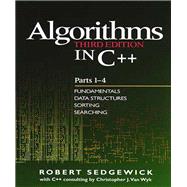
What is included with this book?
Robert Sedgewick is the William O. Baker Professor of Computer Science at Princeton University. He is a Director of Adobe Systems and has served on the research staffs at Xerox PARC, IDA, and INRIA. He earned his Ph.D from Stanford University under Donald E. Knuth.
Christopher J. Van Wyk is Professor of Mathematics and Computer Science at Drew University. The author of Data Structures and C Programs (Addison-Wesley, 1988), he has served on the research staff at Bell Laboratories, where he is now a consultant. Robert Sedgewick and Christopher Van Wyk both earned their Ph.D. degrees from Stanford University under Donald E. Knuth.
| Fundamentals | |||||
|
3 | (24) | |||
|
4 | (3) | |||
|
7 | (4) | |||
|
11 | (11) | |||
|
22 | (2) | |||
|
24 | (3) | |||
|
27 | (42) | |||
|
28 | (5) | |||
|
33 | (3) | |||
|
36 | (8) | |||
|
44 | (5) | |||
|
49 | (4) | |||
|
53 | (6) | |||
|
59 | (10) | |||
| Data Structures | |||||
|
69 | (60) | |||
|
70 | (13) | |||
|
83 | (8) | |||
|
91 | (6) | |||
|
97 | (9) | |||
|
106 | (4) | |||
|
110 | (6) | |||
|
116 | (13) | |||
|
129 | (72) | |||
|
140 | (4) | |||
|
144 | (3) | |||
|
147 | (6) | |||
|
153 | (5) | |||
|
158 | (8) | |||
|
166 | (9) | |||
|
175 | (4) | |||
|
179 | (13) | |||
|
192 | (6) | |||
|
198 | (3) | |||
|
201 | (64) | |||
|
202 | (8) | |||
|
210 | (12) | |||
|
222 | (8) | |||
|
230 | (10) | |||
|
240 | (3) | |||
|
243 | (6) | |||
|
249 | (6) | |||
|
255 | (6) | |||
|
261 | (4) | |||
| Sorting | |||||
|
265 | (50) | |||
|
267 | (6) | |||
|
273 | (1) | |||
|
274 | (3) | |||
|
277 | (2) | |||
|
279 | (6) | |||
|
285 | (8) | |||
|
293 | (6) | |||
|
299 | (8) | |||
|
307 | (5) | |||
|
312 | (3) | |||
|
315 | (32) | |||
|
316 | (5) | |||
|
321 | (4) | |||
|
325 | (3) | |||
|
328 | (3) | |||
|
331 | (5) | |||
|
336 | (3) | |||
|
339 | (2) | |||
|
341 | (6) | |||
|
347 | (26) | |||
|
348 | (3) | |||
|
351 | (2) | |||
|
353 | (4) | |||
|
357 | (2) | |||
|
359 | (4) | |||
|
363 | (3) | |||
|
366 | (4) | |||
|
370 | (3) | |||
|
373 | (44) | |||
|
377 | (4) | |||
|
381 | (2) | |||
|
383 | (6) | |||
|
389 | (7) | |||
|
396 | (6) | |||
|
402 | (4) | |||
|
406 | (11) | |||
|
417 | (34) | |||
|
419 | (4) | |||
|
423 | (4) | |||
|
427 | (8) | |||
|
435 | (4) | |||
|
439 | (3) | |||
|
442 | (5) | |||
|
447 | (4) | |||
|
451 | (38) | |||
|
453 | (5) | |||
|
458 | (8) | |||
|
466 | (6) | |||
|
472 | (6) | |||
|
478 | (11) | |||
| Searching | |||||
|
489 | (54) | |||
|
491 | (8) | |||
|
499 | (3) | |||
|
502 | (8) | |||
|
510 | (5) | |||
|
515 | (6) | |||
|
521 | (4) | |||
|
525 | (4) | |||
|
529 | (4) | |||
|
533 | (10) | |||
|
543 | (44) | |||
|
547 | (7) | |||
|
554 | (6) | |||
|
560 | (5) | |||
|
565 | (10) | |||
|
575 | (8) | |||
|
583 | (4) | |||
|
587 | (36) | |||
|
588 | (9) | |||
|
597 | (5) | |||
|
602 | (6) | |||
|
608 | (5) | |||
|
613 | (4) | |||
|
617 | (6) | |||
|
623 | (46) | |||
|
624 | (4) | |||
|
628 | (9) | |||
|
637 | (9) | |||
|
646 | (18) | |||
|
664 | (5) | |||
|
669 | (38) | |||
|
671 | (3) | |||
|
674 | (2) | |||
|
676 | (15) | |||
|
691 | (12) | |||
|
703 | (4) | |||
| Index | 707 |
The New copy of this book will include any supplemental materials advertised. Please check the title of the book to determine if it should include any access cards, study guides, lab manuals, CDs, etc.
The Used, Rental and eBook copies of this book are not guaranteed to include any supplemental materials. Typically, only the book itself is included. This is true even if the title states it includes any access cards, study guides, lab manuals, CDs, etc.